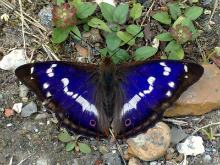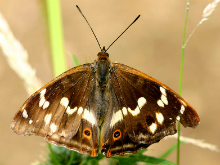
| Butterfly Conservation |
 |
| Hertfordshire & Middlesex Branch |
 |
|
|||
| Saving butterflies, moths and our environment | ||||


Purple EmperorApatura irisLocal in woodland Distribution and Status The Purple Emperor is now more regularly seen in woodland in the two counties. In the 1980s the only confirmed record was in the Hitch Wood area but it is likely that the butterfly existed elsewhere. Due to its elusiveness and presumed rarity many other reports were not accepted. In the 1990s there were sightings at the Broxbourne Woods complex and the last two decades have seen a large expansion starting from the south with sightings recently reported from north Hertfordshire. The reason might owe to increased recording effort and a greater understanding of the insect's ecology among the butterfly fraternity thanks largely due to the efforts of Liz Goodyear and Andrew Middleton (Goodyear & Middleton) Habitat Requirements Large deciduous woodlands although they may occur in small woods if they are part of a larger woodland complex, where sallows are present Larval Foodplants Goat Willow Salix caprea. Other members of the sallow family are sometimes taken, like Crack Willow S. fragilis and Grey Willow S. cinerea Adult Food Sources Ground/mud/road surface, dung, honeydew, rotten flesh, tree sap, Buddleia Buddleja davidii, Sweet Chestnut Castanea sativa Behaviour/Observation notes Both sexes spend most of their time in the tree canopy. Males congregate on 'master' trees, usually of oak, at a high point in the landscape from mid morning and establish territories, often reaching a peak of activity at around 1 pm when the sun is at its highest. The territories will often be found on the edges of woodland and sheltered from the prevailing wind so the northern edge of a suitable wood will commonly be selected. Females will lay eggs away from the sunshine, most likely between around noon and 2 pm. To search for females exhibiting such behaviour in sallow bushes in known localities provides the best chance for finding them close-up. Males, in particular, will sometimes descend to the ground early in the day, to take nutrients from animal droppings and even shrimp paste! When engaged in such activity the butterfly is very approachable so good opportunities for taking close-up photographs are possible Life History Only one generation a year is produced with emergence from the end of June until early August. The peak of abundance is usually around the first week of July. Females will usually lay eggs singly on the upper surface of a sallow leaf in a sheltered spot. Hatched larvae soon enter hibernation attached to a sallow twig. In the spring they turn green in colour and continue feeding on the sallow leaves before pupating beneath a leaf Further information
Comprehensive reports (downloadable) by Liz Goodyear & Andrew Middleton References
Goodyear, Liz and Middleton, Andrew (2008), The status and conservation of the Purple Emperor in Hertfordshire, Transactions of the Hertfordshire Natural History Society Vol 40 pp. 33-77 |
Copyright Butterfly Conservation © 2019 Hertfordshire & Middlesex Branch
Privacy and Copyright Statement and Cookie Policy Statement
Butterfly Conservation
Company limited by guarantee, registered in England (2206468)
Registered Office: Manor Yard, East Lulworth, Wareham, Dorset, BH20 5QP. Tel: 01929 400 209
Charity registered in England & Wales (254937) and in Scotland (SCO39268). VAT No. GB 991 2771 89